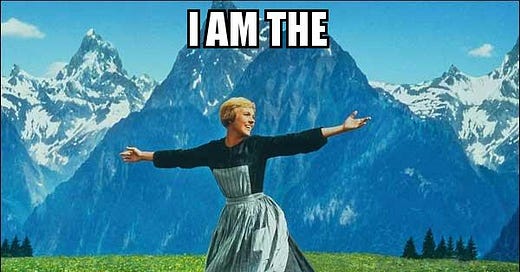Why hello there!
I hope your June is off to a great start. Mine isn’t as I just realized I totally forgot to share a picture of the fake gator head in our community pool with you! (Other than that, my June has been great so far.) I could start this post with it so I don’t forget, but then I’d miss the opportunity to end with “Later Gator.” Can’t beat that low hanging fruit. I hope it’s worth the wait.
I’m really excited about the fact that Substack now allows me to integrate videos within the post rather than just at the top. It will allow me to explore all the things I want to explore in a flowy way. I’m all about that flow.
Well just to be clear, only certain kinds of flow. Like spongebob flow.
Or Julie Andrews flow.
But not Aunt Flo.
Normally I consider myself a welcoming person, but a girl’s gotta draw a line somewhere.
So this is the kind of content you come for, right? Yeah, let’s move on.
If you might be interested in a picture book about…
a civilization of rotten monsters who live on a rotten island and end up destroying themselves
an ugly ogre who, on his way to seek the ugly princess of his dreams, becomes more confident in his ugliness (a character who doesn’t change? Intriguing!)
a witch who pesters her neighbor because she is bored and ends up finding true love
…today’s William Steig deep dive is just for you. (Note: If you don’t want spoilers, watch these read alouds first: ROTTEN ISLAND, SHREK, and WIZZIL.)
Also after I finished recording everything, I discovered that Substack’s video is only compatible with wide shots. In order for you to actually see the books instead of tiny pages only an ant could read, I had to crop it. I hope you enjoy watching my face at an uncomfortable distance.
To read a text-only version of this video, scroll to the P.S. section of this post.
Which one of these books calls to you the most? And what do you think of the ending in WIZZIL?
As promised, here is the gator in our pool! He’s lurking. He’s mean. He’s hungry for ducks. And he makes a great toy for the neighborhood children.
Later gator,
Rachel
P.S. Here is the text-only version of the William Steig study part III video.
Rotten Island
One of my new favorite Steig books is a fascinating thought experiment – what if instead of inspiring joy, beauty inspired destruction? What kind of world would that happen in? Rotten Island, of course. A place full of ugly creatures where rottenness is the comfort zone. Until a beautiful flower disrupts their rotten paradise and they freak out, eventually destroy themselves, and the island is reborn beautiful.
As I read this book, I wondered why Steig waited until over half way through the story before getting to the inciting incident – the moment beauty disrupts the characters’ world. How would the story change without that longer introduction? I did a little experiment to see and realized that because our typical assumptions are rottenness is bad and beauty is good, Steig needed extra time to challenge those assumptions. The way he challenged them was by giving us lots of time to fall in love with his characters. Their specific brand of rottenness. They greet each other by spitting. They resent anyone uglier than them. Steig is the master at revealing an entire world through the eyes of one character. Suddenly we see the world from their specific point of view and maybe even love them for their rottenness.
As we approach the ending, it would be easy to assume Steig is trying to teach us that when we are mean, we destroy ourselves. But it is much more complicated than that. Yes, normally a rotten island and rotten characters getting destroyed would feel like a good thing. Yet we’ve spent time with these characters. We’ve seen their world from their eyes. We know how much they loved their rotten island and how much they would hate that their island was reborn as beautiful. So when everything is destroyed, we feel conflicted. The story has revealed how rottenness can be lovable.
Shrek
Let’s take the idea of lovable rottenness even further in Steig’s movie-inspiring book SHREK. This story is about an ogre who learns in a prophecy that he will wed the ugliest princess. He’s very excited about that so he sets off to find her, overcoming all challenges using his ugliness along the way.
One of the best things about this book is the word choice (which honestly is true of all his books.) Here are some of my favorite lines:
“By the time he toddled, Shrek could spit flame a full ninety-nine yards and vent smoke from either ear.”
“One day Shrek’s parents hissed things over and decided it was about time their little darling was out in the world doing his share of damage. So they kicked him goodbye and Shrek left the black hole in which he’d been hatched.”
“The last thing the peasant saw before he fainted was Shrek’s glare warming up his dinner.”
Aren’t those amazing? You can open up any of Steig’s books and find lines that leap off the page or crackle with energy like these.
We are often taught that in order for a story to be compelling, the main character needs to change (especially in kids’ books); in Steig’s quietly rebellious way, he crafted a story about a character that doesn’t change. How did he pull it off? I think it’s because of the tension between our expectations and the story. If a character starts out ugly, we expect him to become beautiful. A better person. To learn something. Steig plays with this tension the whole way. He even goes so far to place Shrek in a hall of mirrors, confronting the ugliness of himself. Shrek ends up leaving that experience more confident in himself and his ugliness than ever before. In the end, it feels like a win that Shrek doesn’t change. “And they lived horribly ever after, scaring the socks off all who fell afoul of them.” I think these two lived more happily ever after than most as they loved each other’s ugliness; is there a truer love than that?
Wizzil
Maybe. The love story in WIZZIL is also pretty great. Illustrated by the great Quentin Blake, this story is about a witch named Wizzil who decides to torment her neighbor because she is bored. Eventually this puts her in danger, and due to an act of kindness, she finds the love of her life.
Again, Steig is the master of word choice. Here are a few favorites from this story:
“Wizzil took her parrot’s advice, turned herself into a common housefly, and zizzed on over to Frimp Farm to check it out incognito.”
“Snoozing and snoring with a flyswatter in his fist, was DeWitt Frimp.”
“Once she got home, Wizzil hurled her body onto her bed and stared at the ceiling as if she dared it to try staring back.”
With just those few lines, you know exactly who these characters are. Steig gives his readers both space and trust to pick up on clues about what each character really needs. In fact, the satisfaction of the ending depends on it. Now here I would normally go into analysis mode of why the ending works so well but since many of you probably haven’t ever read this one, I’m going to follow Steig’s lead and give you the space to explore it on your own. But I’d love to hear your thoughts in the comments.








You already know I think Steig was an absolute genius -- one of the greatest children's authors of all time, imo -- and his word choices were mind-blowing, I mean no one, NO ONE is better at this than him. And I adore you analysis of all three of these books, each of which I love for many different reasons (not least of which is their subverting of the dominant paradigm).
As for the ending in Wizzil: it feels right. It might not be as revolutionary as Rotten Island or Shrek, but I think it fits the characters and the story. It has truth in it, not in a saccharine way, but in an honest, sometimes-things-happen-like-this way that I like -- probably only because it's Steig, and I trust that he's not just ending it this way to, like, fit the trope, but because that's the way it really should have ended for Wizzil. (If any of that makes ANY sense 😂)
Just found you ! 🙌